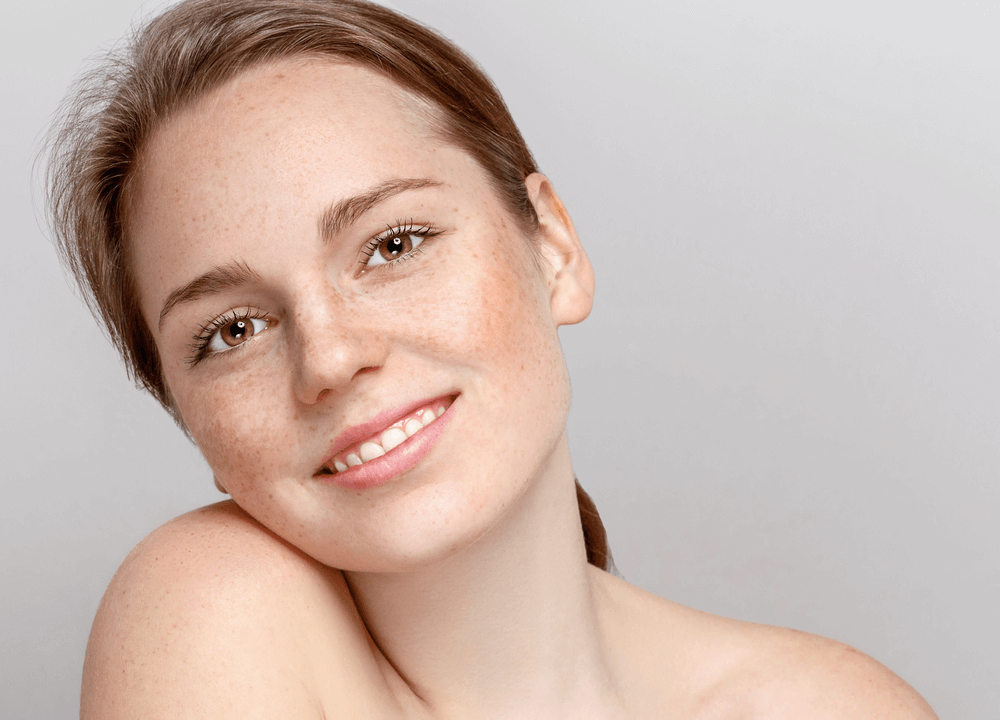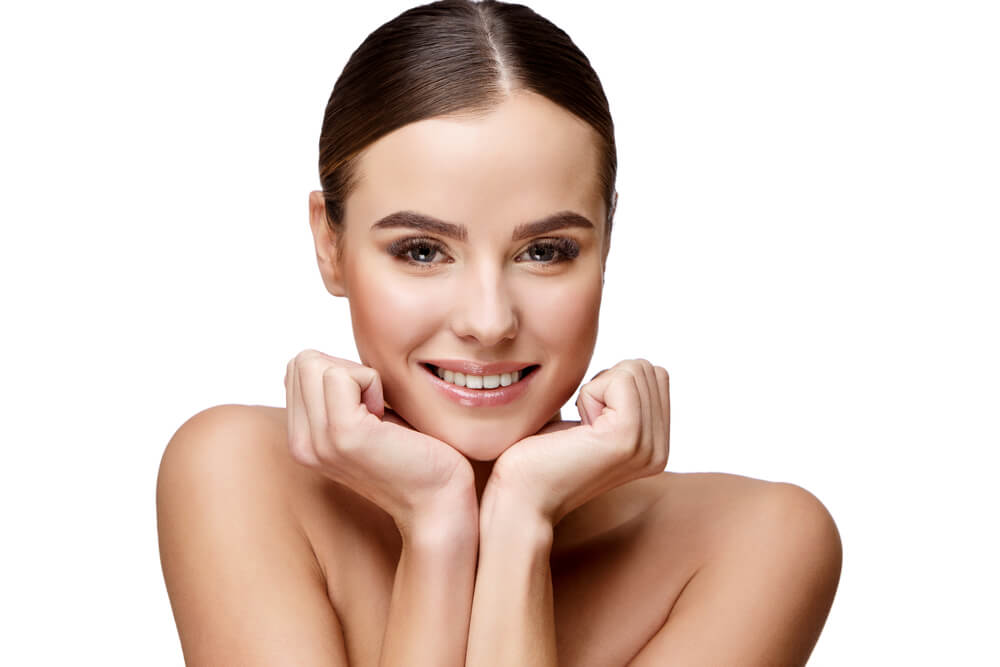
Your rosy cheeks may have been adorable when you were five, but not so much anymore. If you’ve been struggling your whole life with attempting to cover up the redness in your skin, we feel your pain! Nobody likes a band-aid fix, so we’re here to tell you how to calm down the redness for good. Before you stop reading because you think your slight pink flush isn’t rosacea, think again. We hate to be the bearers of bad news but if you’re rocking a blushing veil when you don’t mean to be, it’s rosacea. However, fear not, because of course, we have a solution for our NuAGE babes.
First, What is Rosacea?
Rosacea is a common skin disease that often begins simply as a tendency to blush or go flush more easily than others. In the early stages, it can come and go, sometimes triggered by things we encounter, like spicy foods or alcohol. Over time, the redness may get more persistent and show up more frequently, making it harder and hard to ignore. The most common areas for the redness to occur are the cheeks, nose, chin, and forehead. Rosacea can even involve the eyes as well, leading to symptoms such as bloodshot eyes and a gritty, dry feeling.
Beyond the redness, rosacea, in its different forms, can even cause other kinds of inflammation, including acne. And, like acne, rosacea comes in different types or stages. Here’s the breakdown:
- Mild rosacea, or erythematotelangiectatic (ERT) rosacea, is the most common form of rosacea. It’s categorized by redness, flushing and some visible capillaries or spider veins. With this type, flare-ups are most common. In other words, the symptoms may not always be apparent. Skin can also be swollen, dry, rough, scaly or overall very sensitive.
- Moderate rosacea, which consists of redness, swelling and acne-like breakouts that come and go is known as papulopustular rosacea. Like it’s milder counterpart, those with papulopustular rosacea may too experience sensitive, burning or stinging skin, as well as spider veins or visible or broken capillaries. However, given the acneic nature of this form of rosacea, the skin might also be oily or have raised patches called plaques.
- When rosacea takes a turn for the severe, it’s referred to as phymatous rosacea, which results in thickening of the skin with a bumpy texture. This type of rosacea is rare, although patients suffering from it often see signs of other types of rosacea first, such as broken blood vessels. The skin may also be oily with large pores. The nose is most commonly affected by phymatous rosacea and the thickening of the tissue creates a bulbous and enlarged nose. This phenomenon is known as rhinophyma. Skin may also become thickened on the forehead, cheeks, chin and ears.
What Causes Rosacea?
Rosacea is most common in fair skin types and is thought to affect somewhere around 1 in 20 people, although it’s frequently misdiagnosed or simply just missed altogether, meaning that number could very well be much higher. Similar to acne, there is no one known cause for the condition. For years, experts and health professional have debated the cause and best treatment options. Given the different severities and combination of symptoms, it can be tricky to find a single solution for everyone.
Generally speaking, rosacea is caused by one of two things: extrinsic (external) or intrinsic (internal) factors. The first external factor being a weakened or too-thin of a barrier or acid mantle on the skin’s surface. Our acid mantle, sometimes referred to as the hydro-lipid film, is a film on the surface of our skin that acts as the interface between your skin and the world. Much like the name implies, our acid mantle is what makes our skin slightly acidic in pH. This is important as it contributes to our adaptive immune system and helps to protect us from bacteria and harmful molecules in our environment.
As we go through life, not protecting our skin from sun exposure can break down this barrier year by year. Using products that are full of alcohol or stripping ingredients can also contribute to the breaking down of this vital function. Since one of the jobs of your acid mantle is to keep out the bad and keep in the good, if it’s compromised for any reason, you’ll end up with inflammation because there’s nothing determining the balance is in check.
How to Treat Rosacea
So, what do you do? First: sunscreen. Every day, rain or shine. Not only is a good sunscreen the #1 anti-aging product you can have in your arsenal, it’s also important to use every day because the damaging rays from the sun can penetrate right through cloud coverage! Finding a good sunscreen that contains anti-inflammatories is extra points! Lack of sunscreen will keep the skin inflamed, so no treatment is effective. Next, focusing on products that replicate your barrier function while you work to repair the skin is crucial.
Internal factors could be triggered by hormones, gut health/digestive imbalance or a food allergy. To get to the bottom of these internal factors that are causing inflammation, we recommend taking a whole body approach by seeing a naturopath (we happen to know an amazing Vancouver naturopath, just saying.). There’s significant evidence to support that gut health is paramount for skin health. If we think about how our skin looks or feels after we’ve had a bout of eating poorly, we know that this statement is true. If you address inflammation in the small intestine, or even a possible bacteria overgrowth, you’ll likely see your rosacea symptoms clear up almost immediately. Certain supplements, such as probiotics, may clear up your symptoms long-term and keep the condition at bay.
Now, while laser therapy won’t necessarily cure the internal factors of rosacea, it will certainly help things along! Once you address and repair your skin’s barrier and give it the extra protection (SPF) that it desperately requires, we can then focus on the deeper layers of your skin. For a varying combination of symptoms, we can turn to IPL, Laser Genesis and laser for veins to kick the signs of rosacea to the curb. In some cases, a combination of each treatment will be used to rid the redness or texture from rosacea, but it really depends what bothers you most.
Get Rid of Rosacea. Book a free consultation today
Laser Genesis for Rosacea
If you’re really just looking to help strengthen the skin and address textural concerns or if you’re struggling with acneic rosacea, Laser Genesis is the treatment for you. This treatment can be used when your skin is weakened or sensitized to help stimulate the repair and strengthening of the barrier functions. When it comes to controlling acne breakouts and oil production, this treatment really takes the gold.
How it works: After a relaxing cleanse and microdermabrasion, we section your skin into a grid-like pattern and hover the laser over your skin box by box, bringing your internal temperature to roughly 39-41 degrees. The laser stimulates collagen and elastin production and, as a bonus kills any acne-causing bacteria present in the skin.
IPL for Rosacea
For most of us, rosacea shows as a pesky, persistent rosy flush. This is a tell-tale sign, and often what bothers us most. If you want to say goodbye to the blush once and for all, IPL will be your go-to to rid yourself of the diffuse redness.
How it works: When our skin is inflamed, it can cause inflammatory cells and blood cells to pool just below the surface, creating the persistent blush. With IPL, we can shoot pulses of light laterally into the skin to help push that redness further down so that your lymphatic cells can take over and flush everything out for good.
Laser for Veins
Now, if visible capillaries, usually on the cheeks or nose, are your primary concern, we’ll use the Nd: YAG laser for veins technology. This will eliminate any visible or broken capillaries that have made their way to the surface of the skin.
How it works: Imagine the network of veins and capillaries that run through the deepest layers of your skin and imagine that each of these little veins has a valve at one end. Prolonged inflammation can cause this valve to ‘loosen’ and now too much blood will flow through the vein causing it to dilate and stretch out, making it more visible on the surface of the skin. By using laser, we trace the vein, creating tiny micro-punctures, causing the excess blood to drain out and the now weak vein to collapse. Over the course of a few weeks, your lymphatic system will work to clean up and flush out the leftovers.
As you can see, there is hope! By protecting your skin, using the right products, treating redness from the inside out, enlisting the help of a laser, or any combination thereof, you can banish that unwanted blush.
Book a consultation at NuAGE and our pros will analyze your skin and put our Vancouver rosacea treatments into action.


